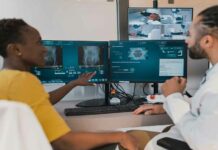If you work in the healthcare sector, it could be important to know about the differences between radiology and nuclear medicine. So, let’s delve in.
Defining Radiology and Nuclear Medicine
The field of radiology encompasses various imaging techniques, including X-rays, computed tomography (CT) scans, and magnetic resonance imaging (MRI).
These diagnostic tools allow medical professionals to visualize the internal structure of the body in a non-invasive manner.
On the other hand, nuclear medicine utilizes small amounts of radioactive material called radiopharmaceuticals to diagnose and treat different conditions.
The Application of Radiology
Radiology plays a vital role in diagnosing injuries and illnesses by providing detailed images of bones, organs, blood vessels, and soft tissues.
For example, an X-ray is commonly used to identify fractures or infections within bones.
CT scans offer three-dimensional images that are particularly helpful for detecting tumors or internal bleeding.
Meanwhile, MRI uses strong magnets instead of radiation to produce high-quality images that reveal subtle differences between healthy and abnormal tissues.
The Role of Nuclear Medicine in Healthcare
Nuclear medicine focuses on the functional aspects of the body at a molecular level.
This approach helps physicians understand cellular function and specific physiological processes taking place inside a patient.
For instance, positron emission tomography (PET) scans can show metabolic activity within cancerous cells or track blood flow after a heart attack.
Therapeutically, nuclear medicine utilizes targeted radiopharmaceuticals to treat conditions like hyperthyroidism or certain types of cancer, such as lymphoma.
Comparing Radiology and Nuclear Medicine Technologists
Both radiology and nuclear medicine technologists play crucial roles within the healthcare system by performing diagnostic imaging procedures.
However, their job responsibilities differ significantly – radiologic technologists focus on acquiring quality images using various modalities like X-rays, CT scans, or MRIs, while nuclear medicine technologists are responsible for preparing and administering radiopharmaceuticals for diagnostic or therapeutic purposes.
Training and Certification Requirements
To pursue a career in either field, one needs to complete an accredited program in radiologic technology or nuclear medicine technology.
Certification is typically obtained by passing a national examination offered by organizations like the American Registry of Radiologic Technologists (ARRT) or the Nuclear Medicine Technology Certification Board (NMTCB).
Your resume for a nuclear medicine technologist position should highlight your educational background, practical experience during training programs, and any relevant certifications.
Job Outlook and Career Opportunities
Employment prospects for both radiology and nuclear medicine professionals are highly promising as medical imaging continues to advance rapidly.
According to the U.S. Bureau of Labor Statistics, the job outlook for radiologic technologists in the U.S. is projected to grow by 7% by the year 2029, while that of nuclear medicine technologists is expected to grow at a rate of 5%.
Opportunities in both fields can be found in hospitals, clinics, outpatient care centers, and diagnostic imaging facilities.
But before applying, make sure you create an excellent resume for nuclear medicine technologist or radiologic roles.
Advancements in Medical Imaging Technology
Technological advancements have revolutionized medical imaging by improving image quality and launching new modalities.
A noteworthy example is hybrid imaging combining techniques like PET/CT or SPECT/CT for enhanced diagnosis and treatment planning.
As these technologies continue to evolve, medical professionals specializing in radiology and nuclear medicine must stay current with industry trends through ongoing education and training.
The Takeaway
Understanding the differences between radiology and nuclear medicine is fundamental for healthcare professionals seeking careers in diagnostic imaging.
While both fields offer promising opportunities and require similar educational backgrounds, their application, job responsibilities, and areas of focus vary considerably.
The path you choose as a medical imaging professional will depend on your interests and commitment to providing quality care for patients using advanced diagnostic tools.
















